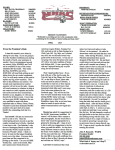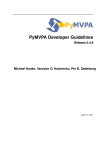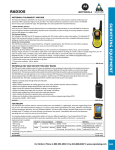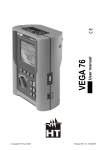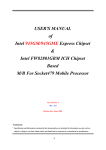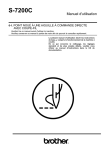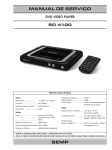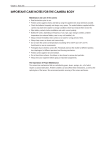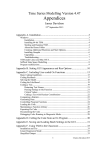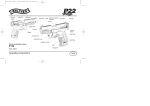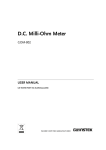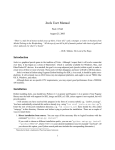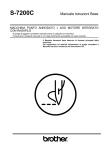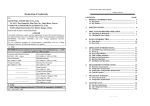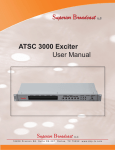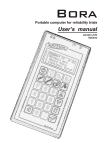Download USER MANUAL Documento descargado de www.kollnerlabrana.cl
Transcript
e D w ocu w m w .k en ol to ln d er e la sc br ar an ga a. do cl d USER MANUAL digital level DL-200 CONTENTS D w ocu w m w .k en ol to ln d er e la sc br ar an ga a. do cl d e FOREWORDS ............................................................................................... 3 PRECAUTIONS: ............................................................................................. 4 SAFETY GUIDE .............................................................................................. 5 OPERATOR................................................................................................... 6 DECLARATION OF EXCEPTIONAL RESPONSIBILITY ........................................... 6 1. NAME OF EACH COMPONENT & ITS FUNCTION ........................................ 7 1.1 Name of Each Component ......................................................... 7 1.2 Operation Keys & Functions ......................................................... 9 1.3 Display.......................................................................................... 9 2. PREPARATION FOR MEASUREMENT.......................................................... 10 2.1 Mounting the Instrument............................................................. 10 2.2 Power On.................................................................................... 11 2.3 Remaining Battery Display .......................................................... 11 2.4 Setting the Data Save Mode ...................................................... 12 2.5 Main Menu ................................................................................. 12 2.6 Staff Collimation and Focus ....................................................... 12 2.7 Surveying Note ........................................................................... 13 3. MEASURE ............................................................................................... 14 3.1 Measure Mode........................................................................... 14 3.2 S.O GH (Stake out Ground Height).............................................. 15 3.3 S.O HD (Stake out Height Difference).......................................... 16 3.4 S.O Dist (Stake out Distance)....................................................... 17 3.5 Leveling ...................................................................................... 18 3.6 GH&HD....................................................................................... 20 4. ADJUST .................................................................................................. 22 5. PARAMETER SETTING............................................................................... 24 6. DATA MANAGE ...................................................................................... 25 7. OTHER FUNCTIONS................................................................................. 26 7.1 Distance Display [DIST] ................................................................ 26 7.2 Inverse Staff Mode [-].................................................................. 26 7.3 Horizontal Angle Measurement .................................................. 26 7.4 Optical Distance Measure.......................................................... 26 8. BATTERY AND CHARGER ......................................................................... 27 9. CIRCULAR VIAL ADJUSTMENT .................................................................. 27 10. TRANSPORTATION, STORING AND CLEANING ........................................ 27 11. SPECIFICATION .................................................................................... 29 2 FOREWORDS Congratulations on your purchasing the Digital Level DL-202. In order to operate this instrument correctly, please read this user manual carefully and keep it well so as to refer to it easily in the future. Before use, please check the standard features and make sure all the equipments and accessories are available. D w ocu w m w .k en ol to ln d er e la sc br ar an ga a. do cl d e In order to facilitate reading, some pictures are simplified. 3 PRECAUTIONS: D w ocu w m w .k en ol to ln d er e la sc br ar an ga a. do cl d e Before using this instrument, please make sure that each function is running well. ●Avoid to make the surface of the digital staff as well as the joints between each section dirty or damaged, otherwise it will influence the accuracy of reading and measurement. This is because the instrument needs to transfer the black & white bar code to electric signal. That’s why in case the digital staff is dirty, the accuracy would be decreased, or even the instrument is not able to measure. ●Tripod The digital level should be mounted on wooden tripod. Metal tripod is lighter and it’s easy to shake, which will affect the accuracy. Each leg of the tripod should be fixed well by screws. ●Tribrach In case the tribrach is installed not properly, the accuracy would be influenced. Please inspect the adjusting screw on the tribrach frequently and make sure the central fixing screw is tightened. ●Packing well to avoid the instrument shaked As an precise instrument, the digital level should be handled carefully to avoid shaking and crashing during transportation. Severe shaking would damage the measurement functions. When packing the instrument in the case, make sure it is powered off and take off the battery. ●Carry the instrument carefully When you need to move the instrument, you must grasp the lifting handle and take it off from the tripod. ●Avoid to expose the instrument in sun, rain or humid condition Leaving the instrument in place of high temperature (+50℃) would damage the instrument. Do not shoot the sun with the objective lens, otherwise the spare parts inside the instrument may be damaged. ●Avoid a great change on temperature A great change on instrument temperature would decrease the measuring range. For example, when the instrument is moved out from a hot car, please leave the instrument to adapt to the surrounding temperature before use. ●Battery Inspection Check the remaining battery before use. ●Digital Staff Wear a glove when using a digital staff. 4 SAFETY GUIDE D w ocu w m w .k en ol to ln d er e la sc br ar an ga a. do cl d e Serious injury or even death may occur if the following cautions are ignored. ●In case of explosion, do not place the instrument close to inflammable gas, liquid, or solid. Do not operate it in coal mine or dusty place. ●Do not disassemble or repair the instrument without authorization in case of possible dangers occurred like fire, electric shock or damage. Disassembling and maintenance are only implemented by the manufacturer and its authorized service providers. ●Do not use the telescope to sight at the sun or sunlight that are refracted by reflectors like prisms in case of any hurt to the eyes. ●Be careful to operate the instrument with the digital staff near high voltage cables or transformers, in case of electric shock accident. ●Do not use the digital staff when there are thunder and lightning in case of electric shock. ●Do not use chargers and batteries that are produced by a third party in case of fire. ●Do not use a broken power supply, wires, sockets and plugs in case of fire or electric shock. ●Do not use humid batteries or chargers in case of fire or electric shock. ●Do not place the batteries in fire or high-temperature environment in case of explosion or damage. ●Do not use the power supply mentioned in the manuals of non-manufacturers in case of fire or electric shock. ●Avoid short circuit when storing the batteries in case of fire. ●Do not disassemble or assemble the instrument or operate the plug with wet hands in case of electric shock. ●Do not cover the charger when it is charging in case of fire. ●Do not touch the liquid leaked from the battery in case of hurt by the harmful chemicals. And please change the battery. ●Injury to persons or damage to goods may occur if the following cautions are not followed by operators. ●Harm: means hurt, burn, electric shock, etc. ●Damage: means serious damage caused to building, instrument or furniture. ●Overturning the instrument case may damage the instrument. ●Do not stand or sit on the case. ●Do not use the instrument case with broken belt, buckle, hinge, or lifting handle, in case that the instrument is damaged or it hurts the legs if the case falls. ●When mounting or delivering the instrument, please be careful that the leg tips of the tripod may hurt people. ●Please make sure to mount the tribrach correctly. Serious damage will occur if the tribrach falls from the tripod. ●When mounting the instrument on the tripod, make sure the central fixing screw is tightened well to prevent the instrument from falling from the tripod. ●When mounting the instrument, make sure the screws of the tripod are tightened well. ●When moving the tripod, make sure the screws of the tripod are tightened 5 well. OPERATOR ●This instrument is only operated by specific persons. It is required that the operator should be a qualified surveyor. Before operation, inspection and calibration, operators should be acknowledged the safety guide. ●During using the instrument, please wear necessary suits for protection (e.g. safety shoes, safety helmet). ●Do not place the instrument directly on the ground. If the operator has to leave the instrument alone, please cover the instrument with a nylon cover (if available). DECLARATION OF EXCEPTIONAL RESPONSIBILITY D w ocu w m w .k en ol to ln d er e la sc br ar an ga a. do cl d e ●Users of this product should read the user manual thoroughly and implement periodical inspection to the performance of the instrument. ●Manufacturer and its dealers shall not be responsible for any direct or indirect consequences and profit loss resulted from destructive or intentional improper use. ●Manufacturer and its dealers shall not be responsible for any direct or indirect consequences and profit loss resulted from natural calamities (e.g. earthquake, hurricane, flood, etc.), fire, accidents, or fault of a third party. ●Manufacturer and its dealers shall not be responsible for failure to operate resulted from the fact that the data is changed or lost, or that operation is interfered. ●Manufacturer and its dealers shall not be responsible for any consequences and profit loss resulted from extra use without following the user manual. ●Manufacturer and its dealers shall not be responsible for any consequences and profit loss resulted from improper transportation or connecting with other products. 6 1. NAME OF EACH COMPONENT & ITS FUNCTION D w ocu w m w .k en ol to ln d er e la sc br ar an ga a. do cl d e 1.1 Name of Each Component 7 battery rough collimator LCD display keyboard panel keys eyepieces: use for adjusting the definition of the crosshair. protecting cover of eyepieces: by releasing this cover, you can implement the mechanical adjustment of the reticle in order to correct the optical collimation line error. 8 data transfer port: connecting with PDA or computer. 9 reflector of circular vial 10 circular vial 11 tribrach 12 lifting handle 13 model label 14 objective lens 15 focusing hand wheel: use for focusing of digital staff. 16 power/measure key: use for instrument power ON/OFF, and measure. 17 horizontal tangent hand wheel 18 horizontal dial: use for setting the horizontal direction value of the collimating direction to 0 or other required values. 19 leveling screws of the tribrach D w ocu w m w .k en ol to ln d er e la sc br ar an ga a. do cl d e 1 2 3 4 5 6 7 8 1.2 Operation Keys & Functions key name POW/MEAS ↑↓ →← menu distance measure select number moving ENT ESC enter ESC Power ON/OFF, and start to measure. Power ON: press once; Power OFF: hold on for 2 seconds. Return to the menu list. In measurement status, press it to start measure the distance and display the distance. Turn the page of menu list or data list. Turn the left or right page when viewing the data, or move left or right in inputting status. To confirm the parameters or inputting data. To escape from menu mode or any setting mode. Also to go backspace to delete a character in inputting mode. Inputting numbers. Use for inputting inverse staff. Set the inverse staff. You should activate this function in parameter setting first. Turn ON/OFF the illumination 0~9 - D w ocu w m w .k en ol to ln d er e la sc br ar an ga a. do cl d e MENU DIST Power ON/OFF measure function number keys Mode of setting inverse staff illumination . decimal point Inputting a decimal point 1.3 Display The display adopts dot matrix LCD, displaying 2 lines, with 16 characters in each. LCD illumination ON/OFF. By pressing to turn ON or OFF the illumination. It is also available to set it in instrument parameters. Setting Contrast There’re 9 degrees for the contrast. Please refer to parameter setting to know how to set the contrast. 9 2. PREPARATION FOR MEASUREMENT 2.1 Mounting the Instrument Placing the Tripod. Type E aluminum tripod with flat or dome head tripod is required. (1) Adjust the three legs of the tripod to a proper length and tighten the fixing screws at the middle of the leg. (2) Tighten the hexagonal nut on the head of the tripod in order to make the tripod legs not too loosen. Place the tripod on a certain point, expand the legs until the distance between each leg is about 1m. First, fix a leg, and move the other 2 legs to make the head of the tripod approximately leveled. If necessary, adjust the length of the tripod legs. (3) Trample the legs into the earth or fix it well on the ground. D w ocu w m w .k en ol to ln d er e la sc br ar an ga a. do cl d e Putting the Instrument on the Head of the Tripod. Take out the instrument from the case carefully and place it on the head of the tripod. (1) Aim the tripod central screw to the center of the tribrach center and tighten the screw until it is fixed at the head of the tripod. (2) If you need to define an angle or a line through the horizontal dial, you should center the instrument precisely with a plummet. (3) Center the circular bubble by adjusting the three leveling screws of the tribrach. If you are using a dome headed tripod, you should slightly loosen the tripod central screw and rotate the instrument round the head of the tripod until the circular bubble is centered, then tighten the screw. Mounting the Instrument on a Certain Point (centering) If you need to measure an angle or alignment, please precisely center the instrument at a certain point with a plummet. (1) Hang the plummet at the plummet hook of the central screw of the tripod. (2) Adjust the plummet line to a proper height. (3) In case the instrument is not centered at the known point, you can move the instrument to that point without changing the position relationship between the tripod leg and its head. First, put the tripod on the known point approximately until the plummet is about 1cm away from the point. Second, grasp two legs of the tripod and adjust the tripod by the third leg until the head of tripod is leveled approximately with a proper height. Expand the legs of the tripod and fix it on the ground. (4) Finally, observe the plummet and the hook and trample the legs into the ground. (5) Slightly loosen the central screw of the tripod and move the instrument on the head until the plummet is centered at the known point. Tighten the tripod central screw. Leveling the Instrument Center the circular bubble by adjusting the tribrach screw. First, put the tribrach as the below picture shown. Rotate 2 screws at the same time in opposite direction until the bubble moves to a position where the line between 10 D w ocu w m w .k en ol to ln d er e la sc br ar an ga a. do cl d e the bubble and screw C is perpendicular to the line between screw A and B (refer to Picture A). Then rotate the screw C to move the bubble to the center of the central circle. This procedure should be repeated for times until the bubble is centered on any directions. Picture A Notice: Do not touch the telescope during leveling. Picture B Collimating and Focusing (1) Sight at the digital staff with the rough collimator. (2) Rotate the eyepiece slowly until the image of the crosshair becomes clear. (3) Rotate the focusing hand wheel until the image of digital staff becomes clear. Rotate the horizontal tangent to move the image of the staff to the center of the vertical hair of the crosshair. (4) Observe through the eyepiece. Move your eye slightly up, down, left and right to check whether the relative position between the crosshair and the image of the staff is not changed. If not, please return to step 1. Notice: Measurement accuracy may be influenced if the crosshair and focusing is not clear. 2.2 Power On Press the power key (POW/MEAS). 2.3 Remaining Battery Display The battery symbol indicates the remaining battery. battery symbol Menu ►1. Measure full sufficient 11 half battery low. Please change anther battery or charge the battery. unable to measure. The power will be cut off soon. You need to change the battery. 2.4 Setting the Data Save Mode In order to save the measurement data into the internal memory of the instrument, before leveling measurement, the data saving mode should be set to auto save, as the default setting is “OFF”. 2.5 Main Menu 1st Menu 2nd Menu 3rd Menu 4th Menu e Measure Mode D w ocu w m w .k en ol to ln d er e la sc br ar an ga a. do cl d S.O GH Measure Stake out S.O HD S.O Dist Leveling GH&HD Adjust Meas.Mode Meas Para. Menu Set Ins. Para. Min.Reading Inverse Mode Display Unit Save Mode Auto OFF Contrast Backlight Ins.Info Regis.Info 1.N Times 2.Continuous 1 mm/0.5mm Not Use/Use m(meter)/ft(US. Ft) OFF/Auto/Manual save On/Off Off/On Input PN Search Data Manage Delete Job Input PN/StdMeasData/ LvMeasData/GH/HD Data Input PN/StdMeasData/ LvMeasData/GH/HD Data Check Capa. File Output Input PN/StdMeasData/ LvMeasData/GH/HD Data Format 2.6 Staff Collimation and Focus (1) Focusing Adjust the eyepiece focusing screw until the crosshair can be seen clearly. Then adjust the focusing screw until you can see the staff clearly through the objective lens. 12 A precise focusing can shorten the measuring time and improve the accuracy. Measurement of high accuracy requests precise focusing as well as continuous measures. (2) Obstacles Measurement can be implemented if the staff is blocked less than 30%. Even if the crosshair center is blocked, as long as the field of view is blocked less than 30%, measurement still can be implemented. However, in this case, the accuracy might be affected. (3) Shadow The surveying accuracy may be influenced if the staff is covered by shadow. In some cases, it is not possible to measure. D w ocu w m w .k en ol to ln d er e la sc br ar an ga a. do cl d e (4) Backlight If the background of the staff is too bright, which affects the contrast of the staff, the digital level might not be able to measure. You can cover something ahead of the objective lens in order to reduce the background light invading to the lens. When a strong light comes into the eyepiece, it might not be able to measure either. You can also cover the eyepiece in order to block the strong light from coming into the eyepiece. When the sun is in a low position (for example, in the morning or at night fall), or if the sun light comes into the objective lens directly, it is suggested to block the sunlight with hands. 2.7 Surveying Note In order to make full use of the functions of instrument, please pay attention to the following: (1) Set up the staff in bright place. If possible, prolong the staff completely. If illumination is employed, it is suggested to illuminate the whole staff, otherwise the accuracy might be affected. (2) The shortest distance between instrument and staff is 1.5m. (3) It won’t affect the digital level to measure if the staff is blocked. But if the bar code on the staff is blocked by tree branches or leaves, the digital level might display error, or the accuracy is influenced. (4) If an error occurs because the place where the staff is put is darker than that of the eyepiece, you are suggested to block the light for the eyepiece. (5) Deflection and pitching of the staff may affect the accuracy. During the measurement, make sure the staff is paralleled to the vertical hair of the reticle. The staff should be unfolded completely and fixed well. Make sure the joints of the staff are well and precise. Avoid to measure through the glass window. (6) After a long storage or transportation, check and calibrate the digital and optical sight errors. Then adjust the circular vial and keep the optical parts clean. 13 3. MEASURE 3.1 Measure Mode This mode is to measure the staff reading and distance without calculating the height. Refer to “Set” to set the measure times. Using the average value upon several times can improve the accuracy. Operation Procedure Operation Display 1. Press [ENT] [ENT] Menu ►1.Measure 2. Press [▲] or [▼] to select the Measure Mode and press [ENT]. [ENT] ►1.Measure Mode 2.Stake out ↓ 3. If the saving mode is set to Auto save or Manual save: [ENT] ↓ Job Name? =>B1_ ↓ Standard Mode Press MEAS ↓ Rod: 0.8050m Dist: 8.550m ↓ e Save Data? Y:ENT N:ESC D w ocu w m w .k en ol to ln d er e la sc br ar an ga a. do cl d [1] [ENT] 4. Input the job name and press [ENT]. 5. Collimate the staff until it looks clear and press [MEAS] to measure. The last value after several measures is the average value. Under continuous measure, press [ESC] to stop and record. 6. Press [▲] [▼] to view the point. After saving, the point number will be increased automatically. [MEAS] [▲] [▼] 7. Press [ENT] to confirm or [ESC] to quit. [ENT] to continue or [ESC] to quit. 8. In any process, press [ESC] continuous to return to main menu. [ESC] to quit 14 ↓ Pn Num: P 1 Standard Mode Press MEAS ↓ ↓ 3.2 S.O GH (Stake out Ground Height) Under this mode, user can stake out by inputting the ground heights (GH) of backsight point and stakeout point. Operation Procedure Operation Display 1. Press [ENT] [ENT] Menu ►1.Measure 2.Press [▲] [▼] to select “2.Stake out” and press [ENT]. [ENT] 1.Measure Mode ►2.Stake out ↓ 3.Select “S.O GH” (stake out ground height) and press [ENT]. [ENT] ►1.S.O GH 2.S.O HD ↓ D w ocu w m w .k en ol to ln d er e la sc br ar an ga a. do cl d e ↓ Input BS height BS GH? =100_ m ↓ Input BS height SO GH? =101_ m ↓ 6. Collimate the staff on backsight point until it looks clear and press [MEAS]. [MEAS] Meas BS Pt Press MEAS 7. It displays the backsight staff and the distance. Press [MEAS] to measure continuously or press [ENT] to go to next step, or press [ESC] to quit. [ENT] 8.Collimate the staff on stakeout point until it looks clear and press [MEAS]. [MEAS] or [ENT] or [ESC] 4. Input the ground height of the backsight point and press [ENT]. 5. Input the ground height of the stakeout point and press [ENT]. It displays the stakeout rod reading and the distance. Press [ENT] to display the height and the value to fill or dig. “-” means to fill and “+” means to dig. 9. Press [ENT] to continue to stake out or press [ESC] to quit. 15 ↓ BRod: 0.8050m BDist: 8.550m Meas SO Pt Press MEAS ↓ SRod: 0.6540m SDist: 7.633m ↓ GH: 1.0300m HD: -3.9705m ↓ ENT: Continue ESC: New Meas ↓ 3.3 S.O HD (Stake out Height Difference) User can stake out by inputting the HDs (height differences) of the backsight point and the stakeout point. Operation Procedure Operation Display 1. Press [ENT]. [ENT] Menu ►1.Measure 2.Press [▲] or [▼] to select “layout” and press [ENT]. [ENT] 1.Measure Mode ►2.Stake out ↓ 3.Select Margin Out and press [ENT]. [ENT] 4. Input the GH (ground height) of backsight point and press [ENT]. Input BS height [ENT] 5. Input the HD (height difference) of the stakeout point and press [ENT]. Input VH of stakeout point [ENT] 1.S.O GH 主菜单 ►2.S.O HD ►测量 7. It displays the backsight rod reading and the distance. Press [MEAS] to measure continuously or press [ENT] to go to next step, or press [ESC] to quit. 8.Collimate the staff on stakeout point until it looks clear and press [MEAS]. It displays the stakeout rod reading and the distance. Press [ENT] to display the height and the value to fill or dig. “-“ means to fill and “+” means to dig. 9. Press [ENT] to continue to stake out or press [ESC] to quit. 16 [MEAS] [ENT] [MEAS] or [ENT] or [ESC] ↓ e D w ocu w m w .k en ol to ln d er e la sc br ar an ga a. do cl d 6. Collimate the staff until it looks clear and press [MEAS]. ↓ BS GH? =100_ m SO HD? =1_ m Meas BS Pt Press MEAS BRod: 0.8050m BDist: 8.550m Meas SO Pt Press MEAS SRod: 0.6540m SDist: 7.633m GH: 1.0300m HD: -3.9705m [ENT] ENT: Continue ESC: New Meas 3.4 S.O Dist (Stake out Distance) User can stake out by inputting the distance. Operation Procedure Operation 1. Press [ENT]. Display Menu ►1.Measure [ENT] 2.Press [▲] or [▼] to select “S.O Dist” (stake out distance) and press [ENT]. [ENT] ↓ 1.Measure Mode ►2.Stake out [▼] [ENT] ↓ ►3.S.O Dist Input the distance [ENT] 4. Collimate the staff until it looks clear and press [MEAS]. [MEAS] D w ocu w m w .k en ol to ln d er e la sc br ar an ga a. do cl d 3.Input the distance of stake out point and press [ENT]. e ↓ 5. Displays the distance and the difference. Press [MEAS] to measure continuously or press [ENT] to go to next step, or press [ESC] to quit. When the ∆Rod is positive, it indicates to move the staff backward. When the ∆Rod is negative, it indicates to move the staff forward. 17 [ENT] Input Dist? =50_ m S.O Dist Press MEAS Dist: 30.00m ∆Rod : 20.00m ENT: Continue ESC: New Meas 3.5 Leveling In Leveling mode, the saving mode should be set to “Auto” or “Manual save”. In this session we set it Auto Save. Operation Procedure Operation Display 1. Press [ENT]. [ENT] 2.Press [▲] or [▼] to select “Leveling” and press [ENT]. Menu ►1.Measure [▼] 1.Measure Mode ►2.Stake out [ENT] 4. Input the point number of backsight point and press [ENT]. Input point number [ENT] 5.Select whether to use the existed data. [ENT] e Input job name [ENT] ►3.Leveling 4.GH&HD D w ocu w m w .k en ol to ln d er e la sc br ar an ga a. do cl d 3.Input the job name and press [ENT]. [ENT] Job Name? =>L54_ BS PN =>P1_ Load data? Y: ENT N: ESC ►T01 T02 [ENT] 6. Collimate the staff until it looks clear and press [MEAS]. [MEAS] 8 . Press [►] or [◄] to choose to measure FS (frontsight) point or intermediate point (Int.Pt). Now choose FS first. BRod: 1.2125m BDist: 8.575m [►] or [◄] [ENT] Input point 18 G.H: 30.00m Y:ENT N:ESC Meas the BS Pt PN: P1 7. It displays the backsight staff and the distance. Press [MEAS] to measure continuously or press [ENT] to measure next point. ↓ SelectPtType ►FS Int ↓ ↓ number 9.Input the point number of frontsight point and press [ENT]. 10. Collimate the staff until it is clear and press [MEAS]. FS PN =>P2_ [ENT] Meas the FS Pt PN: P2 [MEAS] FRod: 0.9550m FDist: 8.486m [►] or [◄] [ENT] e Input point number [ENT] SelectPtType BS ►Int D w ocu w m w .k en ol to ln d er e la sc br ar an ga a. do cl d 11 . Press [►] or [◄] to choose to measure BS (backsight) point or Int (Intermediate point). Now choose intermediate point. . 12.Input the point number of the IntPt and press [ENT]. [MEAS] 13. Collimate the staff until the staff is clear and press [MEAS]. [ESC] 14. Press [ESC] and [ENT] to quit. [ENT] Int Pn =>I2 Meas the Int Pt PN: I1 IRod: 0.7395m IDist: 8.501m ENT: Continue ESC: New Meas After measurement, below data will be displayed. After measuring the backsight point, press [▲] or [▼] to show the following screen. BRod:1.022m BDist:15.07m Measurement value of backsight point G H: 21.555m PN: P01 Ground height of backsight point Point number of backsight point When the current measurement finishes, press [▲] or [▼] to display the following screen. 19 FRod:1.032m FDist: 15.07m Measurement value of front sight point G H: PN: 22.555m P05 Ground height of front sight point Point number of front sight point H D: ∑: 0.532m 25.003m Height distance of this station Total length D w ocu w m w .k en ol to ln d er e la sc br ar an ga a. do cl d e When the measurement of interval point is finished, press [▲] or [▼] to display the following screen. IRod:1.022m IDist: 15.07m G H: PN: 21.555m P01 Measurement value of intermediate point point Ground height of intermediate point Point number of intermediate point Explanation about the middle point number of leveling measurement. Before frontsight measurement you can change the point number. It starts with P and 5 numbers following, which will be increased. Those point numbers that are used can be used again. 3.6 GH&HD This mode can measure the GH (ground height) or HD (height difference) of the backsight point before measurement. Operation Procedure Operation Display 1. Press [ENT]. [ENT] 2. Press [▲] or [▼] to select “GH&HD” and press [ENT]. [▼] 20 Menu ►1.Measure ↓ 1.Measure Mode ►2.Stake out ↓ 3.Leveling ►4.GH&HD ↓ Input job name [ENT] 4. Input the job name and press [ENT]. 5.Input the GH (ground height) of the backsight point. [ENT] Job Name? =>H5_ Input BS GH? Y:ENT N:ESC BS GH? =168.680m D w ocu w m w .k en ol to ln d er e la sc br ar an ga a. do cl d Input point number [ENT] Save Data? Y: ENT N:ESC e [ENT] 3. Press [ENT] to save the data. 6. Collimate the staff until it looks clear and press [MEAS]. [MEAS] Meas BS Pt Press MEAS 7. It displays the backsight rod reading and the distance. Press [MEAS] to measure continuously or press [ENT] to measure next point. [MEAS] BRod: 0.841m BDist: 10.005m Meas FS Pt Press MEAS 8. Collimate the staff on the front sight point until it looks clear and press [MEAS]. FRod: 0.841m FDist: 10.005m 9. It displays the frontsight rod reading and the its ground height and height difference. 10. Press [ESC] measurement. to restart the 21 GH:168.479m HD: -0.001m [ESC] Exit? Y:ENT N:ESC 4. ADJUST D w ocu w m w .k en ol to ln d er e la sc br ar an ga a. do cl d e Inspection of the collimating sight line (i angle) of the instrument. (1) As Picture 1 displays, mount the instrument on a tripod between 2 staff which is 50m away from each other. Divide the distance between A and B into 3 sessions with the same distance. (2) Level the instrument. (3) Process: Operation Procedure Operation [▲]or[▼] [ENT] 1. Select “Adjust” in the menu and press [ENT]. 2. Press [MEAS]. 3. Press [ENT]. 4. Press [MEAS]. 22 Display Menu ►1.Measure ↓ ►2.Adjust 3.Set ↓ [MEAS] Adjust a< ----A------b [ENT] Adjust Aa Rod:0.801m [MEAS] Adjust a ----A------ >b Adjust Ab Rod:1.023m 5.Press [ENT]. [ENT] Relocate A------------------ >B You can power off the instrument and move it. 6. Press [MEAS]. 7.Press [ENT]. 8. Press[MEAS]. [MEAS] Adjust a< ----B------b [ENT] Adjust Ba Rod:0.808m Adjust a -----B------ >b D w ocu w m w .k en ol to ln d er e la sc br ar an ga a. do cl d e [MEAS] 9. Press [ENT]. 10. Press [▲] or [▼] and [ENT]. 11.Press [ENT]. 23 [ENT] Adjust Bb Rod:1.030m [▲]or[▼] [ENT] 0.0000m 0” [ENT] 0.0000m 0” 5. PARAMETER SETTING Meas Para. N Times/Continuous 1mm/0.5mm Not Use/Use m(meter)/ft(US. ft) OFF/Auto/Manual save On/Off 1~9 Off/On Date/SN# D w ocu w m w .k en ol to ln d er e la sc br ar an ga a. do cl d e Ins.Para. Meas.Mode Min.Reading Inverse Mode Display Unit Save Mode Auto OFF Contrast Backlight Ins.Info Regis.Info Setting the measuring times of average measurement. Operation Procedure Operation 1. Press [▲] or [▼] and [ENT] to select “Set”. [▲]or[▼] [ENT] [ENT] 2.Press [ENT]. [▲]or[▼] [ENT] 3.Press [▲] or [▼] and [ENT]. [ENT] 4.Press [ENT]. Press times [ENT] 5.Input the times and press [ENT]. 24 Display Menu ►1.Measure ↓ 2.Adjust ►3.Set ↓ ►Meas Para. Ins.Para. ►1. Meas.Mode 2. Min.Reading ►1. N Times 2. Continuous Meas Times? N=1 (1-9) Meas Times? N=5 (1-9) ↓ 6. DATA MANAGE Operation Procedure Operation 1. Press [▲] or [▼] to Data Manage. Display Menu ►1.Measure [▲]or[▼] [ENT] ↓ ►4. Data Manage ↓ 2. Press [ENT]. [ENT] [▲] or [▼] [ENT] ►1.Input PN 2.Search ↓ ►3.Delete Job 4.Check Capa. ↓ ►5.File Output 6.Format ↓ D w ocu w m w .k en ol to ln d er e la sc br ar an ga a. do cl d e 3. Press [▲] or [▼] and [ENT] to select. Input Pn User can input the point number and height to search for the base point in leveling measurement. Search User can search for input point, standard measurement data, leveling measurement data and GH/HD data. Delete Job User can delete input point, standard measurement data, leveling measurement data and GH/HD data. Check Capa. User can check the capacity of the internal memory. File Output User can export the input point, standard measurement data, leveling measurement data and GH/HD data to the computer. (Baud rate:9600, data length:8, stop:1, no parity) According to file types, user can add the extension following the rules below: .L: leveling data .M: measurement data .H:GH/HD data .T:input point data Format: User can format the internal memory. 25 7. OTHER FUNCTIONS 7.1 Distance Display [DIST] Use the [DIST] to measure the distance before surveying, to make sure the distances between the frontsight and backsight are same. 7.2 Inverse Staff Mode [-] Under this model, staff can be inverted for the ceiling measure. Firstly, set the “Inverse Mode” to “Use” in the Meas.Para. setting. Before pressing MEAS, press the [-] button. The battery symbol and symbol “I” will appear alternately on the upper right corner of the screen. That means the Inverse Mode is activated. 7.3 Horizontal Angle Measurement D w ocu w m w .k en ol to ln d er e la sc br ar an ga a. do cl d e This instrument is equipped with a horizontal dial which can be used for horizontal angle measurement. Every 1° with a graduation, every 10° with a mark in the dial, and the graduation increases from 0° to 350° in clockwise direction. (1)First,set up and level the instrument in start point C. Second, sight the telescope to backsight point A, and rotate the horizontal tangent screw until crosshair is accurately on the staff at point A. Rotate the horizontal dial at 0°. (2)Sight the telescope to point B, and adjust the horizontal tangent, until the crosshair is accurately on the staff at point B. And the angle reading is angle between target A and target B, i.e. ∠ACB. 7.4 Optical Distance Measure With the stadia hair of the instrument and the graduation on the staff, you can measure the distance easily. The stadia interval on the staff multiplies 100 is the distance. The stadia interval is the interval between the upper hair and the lower hair on the reticle. (1) Set up the staff on the target point. (2) Set up and level the instrument. Sight the telescope to the staff. Record the stadia interval between upper hair and lower wire as “1”. (3) The distance “L” between instrument and staff is L=100x1. 26 8. BATTERY AND CHARGER The on-board battery is B-21. Charging (1) The output voltage of the charger is AC110V~220V. The electric current is 450mA. (2) Red light means the battery is being charged. Green light means charging is finished. (3) It will take 5 hours to charge the battery. D w ocu w m w .k en ol to ln d er e la sc br ar an ga a. do cl d e Note: a. Charging should be in a temperature of 10℃~40℃ b. When the charging time exceeds the suggested charging time, the battery life might be shortened. c. The battery may discharge in storage. Inspect the battery before use if the instrument is stored for a long time. d. The battery should be stored in a temperature below 30℃, and should be recharged every three or four months. 9. CIRCULAR VIAL ADJUSTMENT 1. Mount the instrument on a tripod. Center the circular vial precisely by rotating the 3 tribrach screws. 2. Rotate the instrument 180°. If the bubble is not in the center, the circular vial should be calibrated as follow: a. Firstly, identify the bubble moving direction, and adjust the corresponding screws to move the bubble half of the offset. b. Level the circular vial with the 3 tribrach screws again. c. rotate the instrument around again to check whether the bubble is centered in every direction. If not, please repeat the steps a & b until the bubble is centered. 10. TRANSPORTATION, STORING AND CLEANING Transportation (1) In outdoor operation, the instrument should be stored in the carrying case, or fixed on the tripod and carried on the shoulder. Make sure not to carry the instrument upside down. (2) In road transportation, do not leave too much space between instrument cases. Normally, the instrument should be stored in a special case in road transportation. (3) In plane, train or ship transportation, the instrument should be stored in original carrying case and carton. (4) Delivering the battery: related law and rules should be totally understood. Inform the carrier before the shipment. 27 Storage (1) Notice the temperature when storing the instrument, especially the temperature inside the car in hot summer. (2) The battery should be removed if the instrument is going to be stored for a long time. (3) Do not store the wet instrument into the case before it is wiped dry. D w ocu w m w .k en ol to ln d er e la sc br ar an ga a. do cl d e Clean (1) Clean the instrument after use. a. If the instrument is wet by seawater, it should be wiped with a wet cloth and then be dried by a dry cloth. b. Wipe the dust on the instrument with a clean brush and a soft cloth. Do not blow it with compressed air. c. Wipe the dust on the objective lens with a clean brush, and wipe it with cotton with mixture of alcohol and aether. (2) When cleaning the plastic parts of the instrument, do not use volatile liquid such as thinner and benzene. Neutral cleansing is suggested. (3) Clean the staff after use, otherwise it will influence the accuracy. Do not use volatile liquid such as thinner and benzene to clean the staff. (4) Store the staff in safe place. It is suggested to cover the joints of the staff with a cloth. 28 11. SPECIFICATION DL-202 minimum display digital reading 1.5mm optic reading 2.0mm digital reading digital reading HD distance D≤10m:10mm;D>10m:D*0.001 1.5m~100m 1mm/0.5mm 0.1/1cm within 3s in normal condition 32× measuring time magnification 3″ 1°20′ 100 0 magnetic-damped >±12′ 0.50″/1′ 16MB increasing mini-B 8′/2mm 5minutes/OFF 1º LCD display of128*32dpi with illuminator D w ocu w m w .k en ol to ln d er e la sc br ar an ga a. do cl d resolving power field of view multi-constant add-constant type range accuracy storage point number connection accuracy e height accuracy (standard deviation for 1km double run leveling) distance accuracy distance range telescope compensator data storage circular vial auto power off horizontal dial graduation display temperature tolerance dimension weight -20℃~50℃ 230 (L)×150 (W)×210mm(H) 2.5kg 29





























